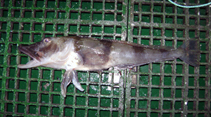Chaenocephalus aceratus (Lönnberg, 1906)
Blackfin icefish
Добавить Ваши наблюдения в Fish Watcher
| Native range | All suitable habitat | Point map | Year 2050 |

|
| This map was computer-generated and has not yet been reviewed. |
| Chaenocephalus aceratus AquaMaps Data sources: GBIF OBIS |
Загрузить свой Фото и Видео
Pictures | Stamps, coins, misc. | Изображение на GoogleChaenocephalus aceratus
Picture by Reyes, P.
Pictures | Stamps, coins, misc. | Изображение на GoogleChaenocephalus aceratus
Picture by Reyes, P.
Common names from other countries
Классификация / Names народные названия | синонимы | Catalog of Fishes(род, виды) | ITIS | CoL | WoRMS | Cloffa
> Perciformes/Notothenioidei (Icefishes) > Channichthyidae (Crocodile icefishes)
Etymology: Chaenocephalus: Greek, chaeno = to yawn + Greek, kephale = head (Ref. 45335).
More on author: Lönnberg.
Etymology: Chaenocephalus: Greek, chaeno = to yawn + Greek, kephale = head (Ref. 45335).
More on author: Lönnberg.
Environment: milieu / climate zone / depth range / distribution range экология
морской демерсальный; пределы глубины 5 - 770 m. Polar; 53°S - 65°S, 67°W - 4°E
распространение страны | регионы FAO | Ecosystems | места находок | Point map | интродукции | Faunafri
Southern Ocean: in the vicinity of Bouvet Island, Scotia Sea, and northern part of the Antarctic Peninsula.
Length at first maturity / Size / Вес / Возраст
Maturity: Lm 44.9 range ? - ? cm
Max length : 72.0 cm TL самец/пол неопределен; (Ref. 4883); common length : 50.0 cm TL самец/пол неопределен; (Ref. 2805); наибольший вес (опубликованные данные): 3.7 kg (Ref. 4883)
Max length : 72.0 cm TL самец/пол неопределен; (Ref. 4883); common length : 50.0 cm TL самец/пол неопределен; (Ref. 2805); наибольший вес (опубликованные данные): 3.7 kg (Ref. 4883)
Adults feed mostly on fish and krill. Synchronous spawner (Ref. 50743). Larvae have a long pelagic phase (Ref. 71843). Utilized as a food fish (Ref. 4931).
Life cycle and mating behavior половая зрелость | размножение | нерест | икра | Fecundity | личинки
There is only one generation of oocytes in the ovaries indicative of determinate fecundity (Ref. 50743). Mature females may spawn for the first time from around 6-8 years of age (Ref. 71843).
Основная ссылка
Upload your references | ссылки | координатор | соавторы
Hureau, J.-C., 1985. Channichthyidae. p. 261-277. In W. Fischer and J.C. Hureau (eds.) FAO species identification sheets for fishery purposes. Southern Ocean (Fishing areas 48, 58 and 88). Rome. Vol. 2. (Ref. 2805)
Статус Красного Списка МСОП (Ref. 130435: Version 2024-2)
уязвимый; см. Красный Список МСОП (VU) (A2bcde); Date assessed: 29 November 2023
Угроза для людей
Harmless
Использование человеком
рыболовство: не имеет хозяйственного значения
FAO(рыболовство: production; publication : search) | FishSource | Sea Around Us
дополнительная информация
Population dynamics
Growth parameters
Max. ages / sizes
Length-weight rel.
Length-length rel.
Размерный состав
Mass conversion
пополнение
численность
Growth parameters
Max. ages / sizes
Length-weight rel.
Length-length rel.
Размерный состав
Mass conversion
пополнение
численность
Life cycle
размножение
половая зрелость
Fecundity
нерест
Spawning aggregations
икра
Развитие икры
личинки
динамика численности личинок
размножение
половая зрелость
Fecundity
нерест
Spawning aggregations
икра
Развитие икры
личинки
динамика численности личинок
Physiology
Body composition
Nutrients
Oxygen consumption
Swimming type
Swimming speed
Visual pigments
Fish sound
Diseases & Parasites
Toxicity (LC50s)
Body composition
Nutrients
Oxygen consumption
Swimming type
Swimming speed
Visual pigments
Fish sound
Diseases & Parasites
Toxicity (LC50s)
Human related
Aquaculture systems
особенности рыбоводства
степень растяжения
Ciguatera cases
Stamps, coins, misc.
Aquaculture systems
особенности рыбоводства
степень растяжения
Ciguatera cases
Stamps, coins, misc.
инструменты
E-book | полевой определитель | определительные ключи | Длина-Частота | онтогенез | карта точек | Classification Tree
| Catch-MSY |
Специальные отчеты
Проверить содержание в аквариумах | Проверить опубликованные видовые данные | Проверить опубликованные данные по аквакультуре
Скачать в формате XML
ресурсы в Интернет
Aquatic Commons | BHL | Cloffa | Websites from users | Проверить FishWatcher | CISTI | Catalog of Fishes(род, виды) | DiscoverLife | ECOTOX | Faunafri | Fishtrace | GenBank(Геном, Нуклеотид) | GloBI | GOBASE | | Google Books | Google Scholar | Google | IGFA World Record | MitoFish | Otolith Atlas of Taiwan Fishes | PubMed | Reef Life Survey | Scirus | SeaLifeBase | Tree of Life | Wikipedia(Вперёд, поиск) | World Records Freshwater Fishing | Zoological Record
Estimates based on models
Preferred temperature (Ref. 115969): -1.3 - 1.6, mean 0 (based on 42 cells).
Phylogenetic diversity index (Ref. 82804): PD50 = 1.0000 [Uniqueness, from 0.5 = low to 2.0 = high].
Bayesian length-weight: a=0.00093 (0.00079 - 0.00110), b=3.48 (3.43 - 3.53), in cm Total Length, based on LWR estimates for this species (Ref. 93245).
Trophic level (Ref. 69278): 3.4 ±0.2 se; based on diet studies.
устойчивость к внешним воздействиям (Ref. 120179): средний (среднего размера), минимальное время удвоения популяции 1.4-4.4 года (K=0.17-0.24; Fec = 7,358).
Fishing Vulnerability (Ref. 59153): Moderate to high vulnerability (54 of 100).
Climate Vulnerability (Ref. 125649): High to very high vulnerability (75 of 100).




